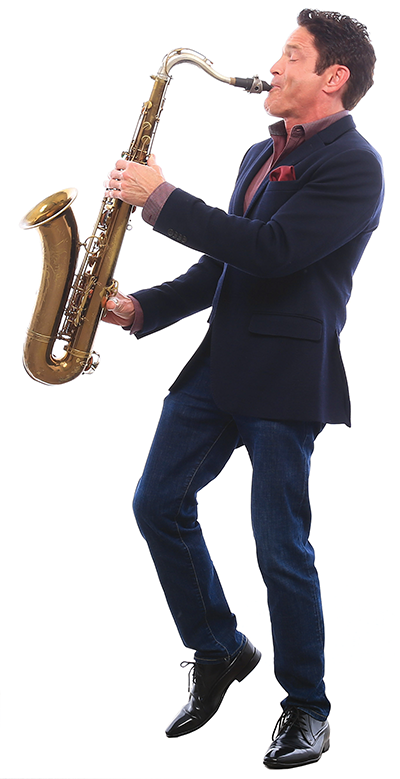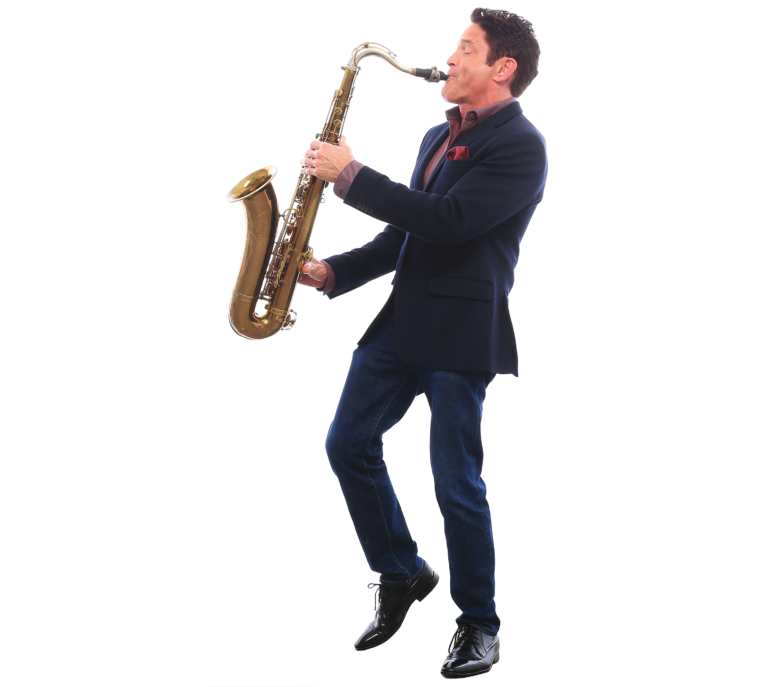Internationally known jazz saxophonist Dave Koz is a native of Los Angeles, but has most often found his muse and inspiration in Sausalito. He’s been renting a cozy getaway home here for most of the 25 years since recording his debut solo album Dave Koz in 1990. During that quarter-century, he’s also been nominated for nine Grammy awards, has had nine albums reach number 1 on Billboard magazine’s Current Contemporary Jazz Albums chart, and received a star on the Hollywood Walk of Fame. Koz released Collaborations: 25th Anniversary Collection, last year on Concord Records. He’s also back with his annual holiday tour, which kicked off the day after Thanksgiving and ends just before Christmas, when he and guests Jonathan Butler, Valerie Simpson and Kenny Lattimore appear at the City National Civic in San Jose on December 22.
 1. You recorded Dave Koz 26 years ago, but how long have you been playing saxophone?
1. You recorded Dave Koz 26 years ago, but how long have you been playing saxophone?
Forty years. I started when I was 13 and when my first album came out I was 27. To me this whole career has been kind of a big surprise. Even when that first record came out I never thought that I would be doing it for this many years.
2. How did you get started?
My older brother had a band, which was called Randy & Company, that played weddings, bar mitzvahs and frat parties. I saw how much fun they had — making money playing on the weekends and not having to sling burgers and fries — so I said, “That’s for me.” Except I didn’t play an instrument. My brother told me the only way I would get in the band was if I played the sax.
3. Had you ever played music before?
I had tried drums and piano and had displayed no discernible musical talent at that point. I remember my dad had come to pick me up from my drum lesson one time — I think I was about 10 — and the teacher pulled my dad close but I could hear him when he said, “You might want to think about sports for Dave because it’s just not going to happen.”
4. So your brother’s comment was what led you to pick up the sax?
That and it’s just such a fascinating instrument. It’s just so sexy and complex. And it just felt right in my hands. I was going through so much crap as a 13-year-old, like most 13-year-olds, but I didn’t have the ability to talk to anyone about what was going on in my head and in my heart. The saxophone became my best friend and most trusted ally and confidant.
5. How did you move from Randy & Company to having a career so far beyond backing a wedding singer?
Being born and raised in Los Angeles, I was exposed to a lot of people and a lot of opportunities. It was really one guy, Jeff Lorber; he saw something in me. And there was another guy named Bobby Caldwell. Those were the two guys who were very well-established artists and they took a chance on me.
6. Any big realizations after a quarter-century of being at a level where you’re putting out albums and touring?
The big takeaway from the 25th anniversary is that there are still people interested in hearing me play! I feel very blessed that somehow me blowing through this metal tube, this plumbing, has struck a chord with people. My favorite thing is turning new people on to it.
7. Given the time of year, the fact you’ve put out a Christmas album, and that you have your annual tour, what does Christmas music mean to you?
Growing up in America means growing up with Christmas music. And I have tremendous respect for the people who wrote the music, because these are the same people who wrote what’s in the Great American Songbook, and that’s music that will never go out of style. These are touchstones in people’s lives. Everyone has that song that will — the moment you hear it — take you right back to a particular moment. Overall, it’s like musical comfort food.
8. You’ve been serving as a global ambassador for the Starlight Children’s Foundation for more than two decades — what drew you to them?
Their mission is to brighten the lives of sick children, not just here in the U.S. but all over the world. Through their various programs, they help to alleviate some of the fear and isolation that kids and their families encounter when facing life-threatening diseases. Imagine a young kid who is in the hospital for long periods of time, a burn victim or leukemia patient — what a scary experience, not just for the child, but for the whole family. I’ve seen the smiles that Starlight puts on these kids’ faces, even for just a few moments, when they’re allowed to forget where they are and be a kid again. It’s the kids that really keep me waving the Starlight flag—they are such heroes to me.
9. Do you have favorite venues you enjoy playing in the Bay Area?
Yes — we started playing our Christmas shows up here at San Francisco’s Masonic Theater way back, many, many years ago. This is the 19th year for our annual Christmas tour, which, for a nice Jewish boy, I don’t quite get even for myself. But I made one Christmas record years ago and here we are. I remember the first time I got to play the Fillmore, and the Great American Music Hall. I played at Slim’s, Bimbo’s — this is going way back to the beginning. Funny, though, that as much time as I spend in Sausalito, I have never played in Marin. I’ve played in Napa and Sonoma, at the Green Center, and I’d love to play up at the Civic Center but it’s never come together.
10. You live in Los Angeles, but maintain a residence in Sausalito — what brought you to Marin in the first place?
I love telling this story. In 1994 I had just finished a very intense promotion project for my album called Lucky Man and I was just a piece of toast. Marin, for whatever reason, was calling to me and I came up for a two-month sabbatical. I stopped off at Golden Gate Market on Second Street in Sausalito to get lunch and I was in line next to this real estate guy, David Grega, who was getting a sandwich. I asked him if he knew of any short-term furnished rentals in town. He said he knew an architect who sometimes rented his house out and he’d give the guy a call. The architect, John Marsh Davis, agreed to meet me and I was soon standing in this house that should be in the pages of Architectural Digest. He agreed to rent the place to me for two months and I ended up staying for a year. Then one rainy night in October there’s a knock at the front door and it’s John, the owner, and he says, “I want my house back.”
11. So you ended up moving back to Los Angeles?
No. The very next day I bought a house on Richardson Street in Sausalito. And I stayed for five years. But when my dad passed away, I felt it was time to move back down south. I sold the house but have always maintained a place up here. But that first house that John Marsh Davis rented to me nurtured me in a way like no other place I have ever lived. It allowed me to come to terms with who I was — I came out, and it gave me the time I needed, which I’d never had before, to really just be OK with me. John passed away in 2009 and he left the house to his niece, who told me, “We’re going to rent the place out — do you want it?” Of course I said I would love it. And so I have this wonderful haven that I call “the Nest.”
12. Any place in particular that you like to hang out when you’re here?
I love the food in Marin County. I spend a lot of time at the Buckeye Roadhouse — it’s in the top four or five places that I love in the world. I love Picco in Larkspur, and Le Garage by the water. We have all those hidden stairways in Sausalito and I love to walk the stairs to have lunch down at Copita or Poggio’s and just walk the streets. One of my favorite things to do is to take the ferry over to San Francisco. I hike in Tennessee Valley and up in the Headlands — the hiking trails in Marin are world-class. But I have to say, even with all the great things there are to do here, the main thing for me is just throwing on sweatpants, looking at the view, writing music and chilling.


